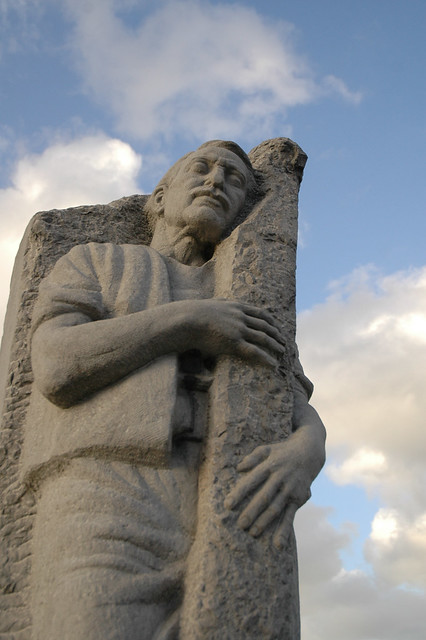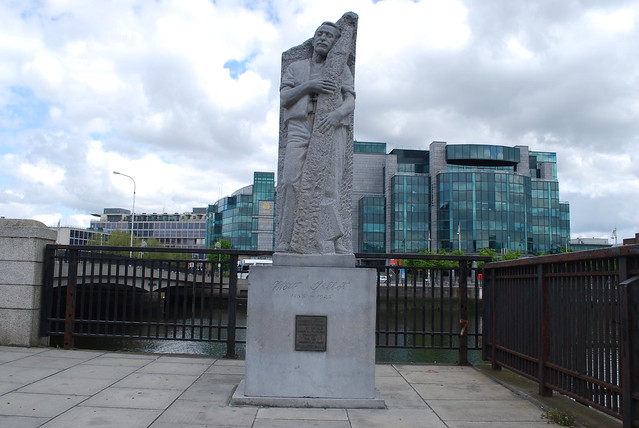These are just two of many online photographs of the Matt Talbot Monument, near Dublin’s Matt Talbot Bridge.The sculpture is by James Power, one of Ireland’s most respected sculptors.

“Matt Talbot (May 2, 1856-7 June 1925) was an Irish ascetic who is revered by many Catholics for his life of self-sacrifice and mortification of the flesh.
Talbot was born the second eldest of twelve children to a poor family in the North Strand area of Dublin, Ireland. His battle with alcoholism from a young age became famous through the posthumous discoveries on his body. Having drunk excessively for 16 years, Talbot had successfully given it up and maintained sobriety for the following forty years of his life. He was known to his peers as a generous and, perhaps surprisingly given what was to follow, happy man who gave much of his wage to the poor as well as played an active part in the Irish Transport and General Workers Union in the city. He was, also, an extremely devout Catholic and was reportedly on the way to his third mass on the day he died. This in itself would have gone unnoticed were it not for the marks and chains discovered all over his body when he died on a Dublin street in 1925.
In a life reminiscent of the Early Christian monks in Ireland, who believed that a life of sacrifice, prayer and devotion would bring them closer to God, chains were found all over Talbot's body. A heavy chain had been clamped securely around his waist with more chains around an arm and another the knee of the devout mass-goer. Some attributed the chains to his repentance for his sins, an interpretation which evokes images of Rodrigo Mendoz's penance in the Roland Joffé movie, The Mission. Talbot's story quickly filtered through to the large Irish émigré communities and within Ireland he rapidly became an icon for Ireland's large temperance movement, the Pioneer Total Abstinence Association.
As word of Matt Talbot spread, countless addiction clinics, youth hostels, statues and much more have been named after him throughout the world from Nebraska to Warsaw to Sydney. One of Dublin's main bridges today is also named after him. Pope John Paul II, as a young man, wrote a paper on him. In 1931, Archbishop Byrne of Dublin opened the sworn inquiry into the alleged claims to holiness of the former dock worker. The Apostolic Process, the official sworn inquiry at the Vatican, began in 1947. On October 3 1975 Pope Paul VI declared him to be Venerable Matt Talbot, which is seen as a step on the road to his canonisation, a process which needs evidence of a physical miracle in order to be successful. Matt Talbot was buried in Glasnevin Cemetery, Dublin, until 1972 when his remains were removed to Our Lady of Lourdes church on Seán McDermott Street, Dublin 1. He remains a legendary figure in the folklore of modern Dublin.”

Matt Talbot Monument
http://www.flickr.com/photos/31068574@N05/4780546840/in/photostream/ by Le Monte 1
Matt Talbot Monument Bronze Information Plaque
Source: http://www.flickr.com/photos/31068574@N05/4779918645/ by Le Monde 1

